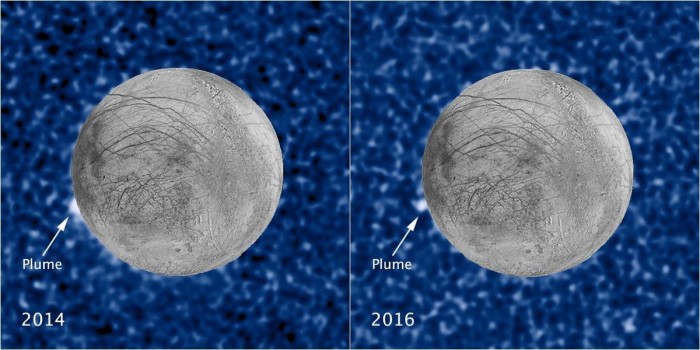As I have ranted from time to time, it pisses me off to no end that NASA sends space probes looking for “conditions that would support alien life” but not for the alien life itself. It literally makes me want to scream sometimes! Now it seems that despite the unconscionable decision to not include any life detecting instruments on deep space probes to Europa, it seems there is an instrument on Europa Clipper that could do it anyway.
The Europa Clipper may only need 1 ice grain to detect life on Jupiter’s ocean moon
The first dedicated mission to this frozen Jovian moon, Europa Clipper is currently scheduled to blast-off in October 2024. It’s expected to arrive in 2030, then perform nearly 50 close fly-bys of Europa, skimming the icy surface at altitudes as low as 25 kilometers (16 miles). The mission’s primary objective is to learn more about the habitability of Europa’s subterranean ocean and the thickness of the ice shell above it. The mission is not designed to find life, to be clear(WTMF!?) — but scientists are now realizing there may be a way.
One of Europa’s fellow ocean moons is Enceladus, a small, icy body in orbit around the ringed planet Saturn. In 2006, the Cassini mission to Saturn discovered plumes of water vapor belching out from Enceladus’ ocean through large fractures in the surface, nicknamed “tiger stripes.”
In 2014, the Hubble Space Telescope observed what appeared to be a similar looking plume towering 200 kilometers (125 miles) above Europa’s surface. Two years later, it saw another plume emanating from the same location. Then, in 2018, NASA astronomers revealed that the old Galileo probe,which operated in orbit around Jupiter between 1995 and 2003, had actually flown through a plume.
Under the assumption that Europa Clipper may also fly through an icy moon plume, scientists led by Fabian Klenner of the University of Washington in Seattle investigated whether the spacecraft’s Surface Dust Analyzer (SUDA) might be able to detect any life carried up from the ocean on the plume. SUDA is designed to study particles of Europa’s surface ice and dust sputtered into space as the moon is constantly bombarded by micrometeorites, but perhaps it could analyze ice grains in the plumes, too.
Simulating high-velocity impacts of ice grains on the instrument in a laboratory would be pretty impractical, so instead Klenner’s team fired a thin, fast-moving jet of water vapor loaded with a bacterium called Sphingopyxis alaskensis into a vacuum chamber. Sphingopyxis alaskensis is found in sea waters off the coast of Alaska, and is at home in cold temperatures and while surviving off few nutrients.
It’s one of the closest things we have to a life-form on Earth that could survive in Europa’s ocean.
More pertinently to the Europa Clipper’s potential for finding such life, the bacteria “are extremely small, so they are in theory capable of fitting into ice grains that are emitted from an ocean world like Enceladus or Europa,” said Klenner in the statement.
The vacuum resulted in the water jet disintegrating into droplets that froze as ice grains. The grains were then studied with a mass spectrometer, mimicking how SUDA will study any grains that it picks up in real life. The results of the experiment showed that Sphingopyxis alaskensis, or at least the parts of it that form ocean scum, could indeed be detected from studying just a single ice grain.
“We have shown that even a tiny fraction of cellular material could be identified by a mass spectrometer on board a spacecraft,” said Klenner. “Our results give us more confidence that using upcoming instruments, we will be able to detect lifeforms similar to those on Earth, which we increasingly believe could be present on ocean-bearing moons.”
